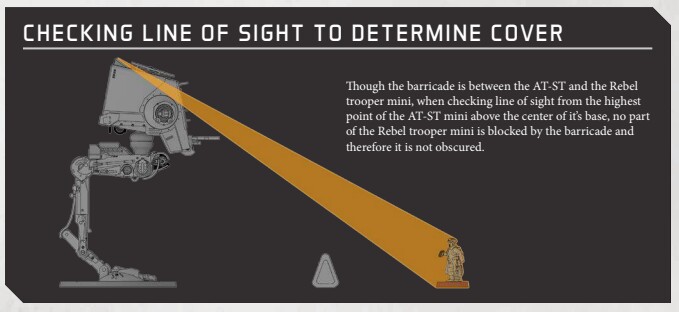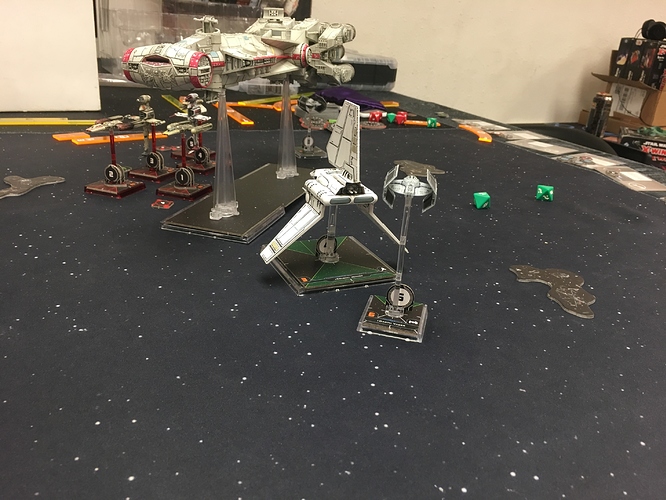From a lore POV Blackstone is interesting as it introduces a Man of Iron, one of the androids from the AI vs humanity wars in the Dark Age of Technology which combined Star Trek level tech with grimdark applications. The MoI is lonely and looking for a friend who understands what its like to be an immortal AI and thinks the Blackstone Fortress will be it. The DAoT provides plenty of opportunities for deus ex machina high tech widgets that can save humanity from its current post-galaxy shattering Chaos victory at Cadia.
Hero Quest is one of my most vivid and fond board gaming memories from my youth. I was just the right age when it came out and I just remember pouring over every detail (was there a functional weapon shop illustration on the inside of the box cover?) and soaking in every ounce of lore. I remember forcing my dad and brother to play session after session despite them not having the same love affair with the game, but they humored me. So good.
Hello, inveterate X-wing player here!
But, as @Juan_Raigada states, it isn’t played on a traditional board, so is a bit of a different case.
But from a visual perspective it certainly makes a difference, the impact of the physical ship model in terms of facing and distance is a big factor.
Doing a cardboard base jus tdoesnt have the same splash, and it would be far less readable, as you try and parse a flat image for which ship it was.
Having played Diskwars, IMO cardboard tokens do just fine.
You’re absolutely right that games like X-Wing and Armada wouldn’t have the same splash. But that’s exactly my point. It’s just splash.
The actual gameplay wouldn’t be the least bit impacted by not having the miniatures. You say there might be readability issues, but I’m not buying that. Games have been doing just fine conveying information in 2D. In fact, the models make it more difficult to navigate the game space, so I’ll go on record as saying X-Wing and Armada (and maybe even tabletop Warhammer skirmishes?) would play better without miniatures, because miniatures add an unnecessary interface complication.
I’m not disputing the splash. I can appreciate the splash as much as the next guy. Kingdom Death Monster would be my go-to for that argument. But I maintain that any game with miniatures would play just as well without them. Take out the miniatures and the actual gameplay won’t suffer one bit.
-Tom
Some pure minis games with LOS rules tied to terrain models and miniature shape and position would not work without minis (the kind of games you use a laser pointer to check LOS). But those are extreme cases and I can’t name one of them I really liked.
But theoretically I could imagine a good design that could only work with minis.
Are there any such games? I’d be curious to know if there are, because everything I’ve seen has gameplay that only relates to the base of a miniature.
-Tom
Many mini systems do, I think even Warhammer 40k 8th edition might do, but I can’t find the rules online. For what I’ve read is that RAW is: “any part of your model can see any part of the target model”. Looking at reddit it seems players ignore it when it’s too silly.
Infinity also does (LOS is defined as any point of the volume of one mini to any point of the volume of another). Although they allow for abstraction through silhouettes, height does still matter.
Look, I think it’s fiddly as hell, but it’s there.
the ones I can think of really leaned into the 3D terrain thing. For Games Workshop stuff, I’m 99% sure that Necromunda and Mordheim both had rules about that. The other one I can think of off the top of my head was the cool minis game Hasbro produced, HeroScape. That one even had silhouettes on each unit’s stat card, showing the parts that were considered targetable (some figs with wings, for example, couldn’t be hit on the wings, and ditto for upheld weapons). Man, I Ioved me some HeroScape.
Contrary to what @CraigM said, I played WIngs of War (the game X-Wing was, ah, heavily inspired by) before it ever had minis- just decks of cards, and it was plenty engaging. Of course, I eventually bought some aftermarket stands and modded in my Crimson Skies HeroClix minis to play with, but that was just for grins.
If anyone wants a cool mini-less substitute for Warhammer: Fantasy Battles, I highly recommend Battleground: Fantasy Warfare. Super cheap to get into- just two $10 decks for a whole multi-thousand-point army (one starter deck and one expansion deck for each army). The cards are a birds-eye view of a unit, and all the measurements are done by card lengths/widths (ex., your movement would be 2L or 2-card-lengths, etc), so no tape measures! The other main cool system they introduced was that at the beginning of your fight, you give all your units ‘standing orders’, and then you have a limited number of Command Points per turn to modify or change those orders, kind of simulating how hard communication was on the battlefield, etc. There were armies for every sort of fantasy race (Humans, Orcs, Lizardmen, etc, etc), and they even did a historical Punic War set (Rome Vs. Carthage), though I can’t vouch for its accuracy.
That does sound pretty cool! But look at how derpy that artwork is:
That doesn’t look like any elf army I’d want to play.

Fortunately, it looks like all the ingame artwork is topdown.
It reminds me a bit of, uh, what was the name of that recent game where cards fought on a grid? You had different factions, and they had different units and powers? I didn’t really care for it, but search me if I can remember the name. There was even a digital version. It wasn’t freeform like Fantasy Warfare, but it played with the idea of cards as units on a board.
-Tom
Ho, hey look! The Battleground: Fantasy Warfare company is doing a relaunch of the game via Kickstarter soon. It originally came out in 2005. That’s crazy. I feel old now.
The artwork was terrible. It was all (early) CG, and it shows. But like you say, it was all top-down, and wasn’t too offensive in that state.
And I think you mean Summoner Wars? It wasn’t bad.
EDIT to add: I just looked at the notes on the redesign of the Men of Hawkshold faction, and yes, they are overhauling the art. And there was much rejoicing!
That’s it! I don’t recall why I didn’t like it. I think a friend brought over the physical copy with two decks, and I couldn’t really appreciate the variety they were going for. I went to look for it on Steam and couldn’t find it. Because it’s only an iOS game. Ugh.
-Tom
Star Wars Legion also uses a physical model LOS for determining cover. So the actual physical placement of the minis is important, as is size and all that. The AT-ST is able to reduce cover compared to infantry, simply because it physically stands taller, and so more opponent models are exposed.
Also there is a whole thing of custom terrain with different floors, geometry, and all that. So that game would definitely lose something if relegated to flat cardboard pieces.
I really liked it, and played a bunch of asynchronous games of it. There was also a decent faction differentiation, so different decks, and faction builds, would play quite differently.
Been a few years though, maybe I should see if anyone is interested.
Star Wars Legion
For the low low price of $50, you can have this height advantage:

So, yeah, I guess that game wouldn’t work with cardboard standees. In other words, the only games that need miniatures are the games made specifically to sell miniatures.
I’m so glad I have zero interest in these “line the toys up” games. One of these days I’ll recoup some of the cost for all those goddamn Star Wars Armada ships I bought. Ugh.
-Tom
Even that could be replicated with an appropriately sized standee, honestly. I mean, if a game literally uses the entire three-dimensional shape of the mini somehow (which seems like it would be super fiddly to me), that wouldn’t be doable with cardboard probably, but just drawing a line from the top of a mini to the other figure? Standees have tops.
Nah in true LOS systems standee substitutes would bloc standees behind them (the AT-AT would have untargetable stormtroopers just behind its legs that with minis are targetable and can target themselves). Also standees are flat, so good luck on getting sideways LOS. The flatness is solved with a cube standee, but the holes / lack of volume around the legs is only solved with something that can better be described as a carboard mini. At that point form is the same and only material changes.
But yeah @tomchick , games that need minis are games designed around selling minis, because, we’ll that’s the game!
It’s a pretty academic discussion anyways. These kind of rule sets are loose by definition and better enjoyed embracing that looseness and these very precise LOS descriptions (any part from a mini traces LOS toany part of a mini… etc) are probably more due to the need to have an instrument to resolve disputes between 14 year old kids than for any core game design issue.
At that point form is the same and only material changes.
That’d still be a change that would dramatically reduce cost.
Oh boy, I’m new and I’m starting my first post with “back in the day”.
Back in the day miniature games had two things going for them. Only a few companies produced rulebooks and miniature lines, so a lot more substitution was allowed. Second, they were closer to skirmish games. You could keep a couple dozen miniatures and be able to play a bunch of different games with them. I remember playing the Battletech and Star Wars table-top skirmish with paper bases and terrain. We also scaled the Warhammer Historical Battles to 10mm so it’d take less space to play. I learned all of this from my local store. People brought in whatever they had and used them for whatever everyone felt like playing.
But every new rulebook upped the number of minis and put restrictions on what could be used. It looks a lot better, but I miss being able to experiment without investing time and money.
As for whether miniatures add anything to gameplay, the old Star Wars game had a great rule for simulating meteor showers: throw a bunch of popcorn at the table and see what it hits.
